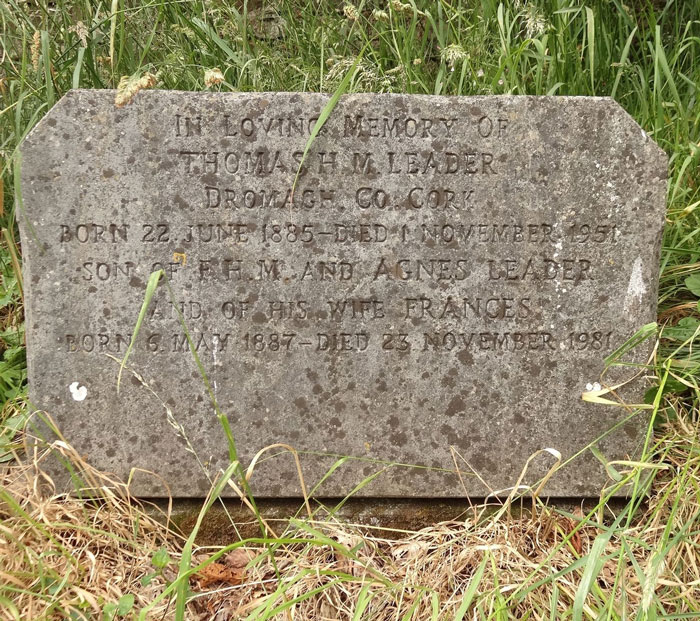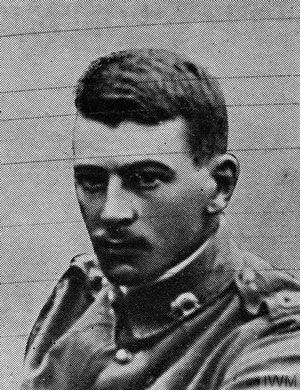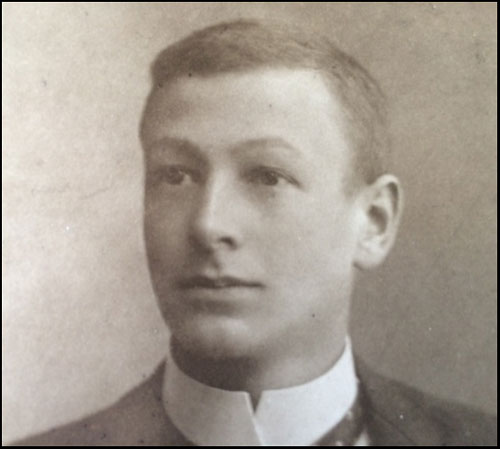Captain Thomas Henry Mowbray Leader
Thomas Henry Mowbray Leader was born on 22 June 1885 at Classas, Coachford, County Cork, son of Royal Artillery officer Francis Henry Mowbray Leader and his wife Agnes Letitia Leader (nee Broderick).
At some time before the war he travelled to Canada where he worked as a rancher and fire-warden in Kelowna, British Columbia. His papers state that he was working as a game-warden in 1914, but it is not clear whether this was in Canada or in England or Ireland.
On 28 August 1914 Leader enlisted in the 2nd Regiment, King Edward’s Horse, at White City, London (No.870). Four months later he applied for a commission and on 3 February 1915 became a 2nd lieutenant and was posted to the North Irish Horse at Antrim. On 30 August 1915 he was promoted to lieutenant.
Leader went to France on 18 November 1915 with F Squadron of the North Irish Horse. Soon after, he transferred to the regiment's C Squadron. C Squadron's war diary makes two references to Lieutenant Leader, on 2 and 18 May 1916:
Lieut T.H.M Leader and working party proceeded to Kemmel for the purpose of Constructing defence works.
Capt F.G Uprichard, Lieut T.H.M Leader & 15 NCOs & men attached to 153rd & 143rd Brigades R.F.A. for a tour of the observation posts of 36th Div. Artillery Front.
In June 1916 C Squadron, F Squadron, and the 6th (Inniskilling) Dragoons Service Squadron came together to form the 2nd North Irish Horse Regiment, serving as corps cavalry to X Corps. Over the next year the regimental war diary includes many references to the activities of Lieutenant Leader:
Lieut Leader, C Squadn left at 8.3.am to take charge of the working party at Contay. (20 September 1916)
Lt Leader rejoined the Squadron with dismounted party of Ammunition Dump fatigue from Contay. (26 September 1916)
Digging party went up as usual under Lieut Leader. (2 December 1916)
Lieut T Leader was in charge of usual Trench digging party. (15 December 1916)
Working party under Lt Leader were again shelled. (30 December 1916)
The working party of which Lt Leader was in charge was again shelled. (5 January 1917)
Usual trench party under Lt Leader. (12 January 1917)
Usual working party under Lieut Leader. They were shelled but no casualties. (24 January 1917)
Usual Trench Digging Party under Lieut Leader. (12 March 1917)
Lieut Leader took dismounted party by train to HQ. (20 July 1917)
In August 1917 orders were received that the 2nd North Irish Horse Regiment would be dismounted and its officers and men absorbed into the 9th Battalion, Royal Irish Fusiliers. Leader was ordered to take a party of seventy men with the regiment’s 265 riding horses to Egypt and hand them over to the British forces there. The party left camp on 14 August, travelling by rail to Beaurainville and then to Marseilles. On 23 August they embarked on the Bohemian, arriving at Alexandria two weeks later.
Leader's party of dismounted Horsemen returned to France, via Italy, in September, joining the 9th Battalion, Royal Irish Fusiliers, in the field at Ruyaulcourt on 5 October.
Leader was posted to the battalion but did not join it. Instead, on 15 November 1917 he left for the UK, where he was attached to the 23rd Battalion of the Tank Corps. By this time he had been promoted to the rank of captain, with seniority from 10 May 1916.
Captain Leader was demobilized on 21 February 1919 and relinquished his commission in the North Irish Horse on 1 April 1920.
He died at Hockley Lodge, Armagh, on 1 November 1951 and was buried at Christ Church Cemetery, Coachford, Cork.

Captain Leader's older brother, Francis William Mowbray Leader, a captain in the 2nd Battalion, Connaught Rangers, was killed in action in 26 August 1914, aged 33. He is buried at Grand-Fayt Communal Cemetery.

Francis William Mowbray Leader
I am grateful to Captain Leader's grandson, Tom Leader, for providing the first image. The second image is sourced from the site Historic Graves. The third image is sourced from the Imperial War Museum - IWM (HU 123985).

